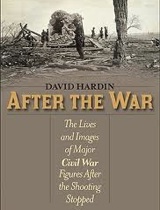After the War: Major Civil Figures After the Shooting Stopped – Book Review
 After the War: The Lives and Images of Major Civil War Figures After the Shooting Stopped. By David Hardin. Ivan R. Dee, 2010. 345 pages, hardcover. $27.95.
After the War: The Lives and Images of Major Civil War Figures After the Shooting Stopped. By David Hardin. Ivan R. Dee, 2010. 345 pages, hardcover. $27.95.
The American Civil War is one of the most written-about conflicts in history, with a plethora of books in print and many more out-of-print. The common denominator among most of these books is their focus on events during the war itself. We know much about the heroism and sacrifice of protagonists during the war. However, not much is written on how those who lived through the Civil War were affected in its aftermath. Thus, David Hardin’s After the War is a welcome addition to Civil War writing.
{default}Hardin’s work profiles 11 people from the war, some well-known and others less so. He tells us of the post-war romance of Jefferson Davis’s daughter with the grandson of a Yankee abolitionist—a romance with inflamed Southern sensibilities, including her father’s. In the aftermath of the war, William T. Sherman fought with his devout Catholic wife and his son over the son’s decision to become a Catholic priest. Bankrupt ex-President Ulysses Grant fought another war, this time to finish his memoirs to provide income for his family before advancing throat cancer claimed his life.
We also learn the tragic story of the downfall of the now well-known Confederate diarist Mary Chestnut as well as the luckless John Bell Hood. There is the story of Nathan Bedford Forrest, whose post-war activities included Ku Klux Klan leadership. Hardin describes the post-war misery and insanity of Mary Todd Lincoln, the stoic Joe Johnston, and the mythological Robert E. Lee. We also come to know Union general George Thomas. Hardin concludes with the tragic figure of George Armstrong Custer. Hardin’s story of Custer focuses on the efforts of his wife, Libbie Custer, to tirelessly defend her husband’s legacy in the aftermath of the disaster at Little Big Horn.
Hardin’s background in journalism shows through in the crisp, newspaper-like writing in this book. It is very well-written and holds the reader’s attention page after page. A nice touch is the fact each chapter includes at least one illustration of that chapter’s subject. It is always helpful for a reader to connect a face to a name. Unlike so many popular history books today, Hardin’s work actually includes endnotes—and excellent endnotes at that. They not only include sources but provide amplifying information as well.
After the War is a great work for answering the question, “Whatever happened to … ?” The only drawback to the work is that it only covers 11 personalities. Perhaps Hardin will write additional volumes to this work, or others will be inspired to take up similar research on the lives of other prominent people following the war. Not only Civil War buffs, but general readers as well will enjoy the stories in After the War.
Steve Schultz is a former active duty Air Force officer and pilot. He holds a master’s degree in military history and writes from southwest Florida.

